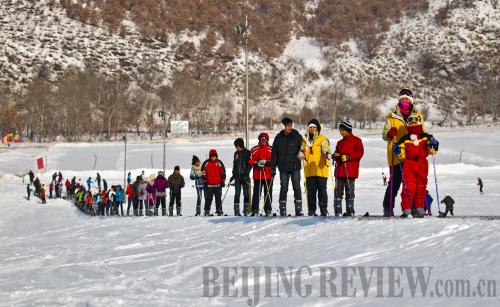|
Gold bonanza
 |
|
TRAVEL FEVER: A group of visitors celebrated the Chinese New Year by skiing in Inner Mongolia on February 8 (WANG ZEWEI) |
During this year's Spring Festival, more people flocked to jewelry stores to snap up valuable trinkets for friends and relatives.
Zhang Li, a 40-year-old entrepreneur in Chengdu, Sichuan Province, paid 6,000 yuan ($912) for two golden cats.
"I placed one at my store in the hope that it would bring me good luck in my investments," said Zhang. "The other is a Lunar New Year gift for my mother."
"I prefer gold to other presents since it offers an effective way to hedge against inflation and maintain a family's fortune," he said.
"The Chinese New Year is the time when people give gifts, usually money in red envelopes, but gold is more popular this year, mainly because inflation fears have taken hold," said Wang Chunli, General Manager of Beijing Caibai Ornaments Store, one of the largest gold retailers in the city. The store sold gold and jewelry valued at more than 300 million yuan ($45.6 million) during the seven-day holiday, up 95.6 percent year on year.
MOFCOM figures also showed gold and jewelry sales at Dashang New Mart Shopping Mall in Dalian, Liaoning Province soared 138 percent and gold and jewelry sales at Guangzhou's Friendship Department Store increased 45 percent from a year ago. Sales of gold and jewelry in Shanghai hit a record high of nearly 500 million yuan ($76 million), according to data from the Shanghai Gold and Jewelry Trade Association.
"The gold market has been burning hot since last year," said Wang Lixin, General Manager of the China office of the World Gold Council. "With the stock markets slumping and the real estate sector subdued, the precious yellow metal has become the best investment."
In 2010, prices of gold futures at the Shanghai Gold Exchange climbed around 23.7 percent. The total volume of gold traded on the exchange totaled 6,046 tons last year, soaring 28.48 percent from 2009.
The trend is likely to keep growing given China's huge population and its expanding spending power, said Wang.
Travel boom
"Tourism has become an important part of holiday celebrations in China," said Dai Bin, Vice President of the China Tourism Academy.
Scenic spots received 153 million visitors from home and abroad during the seven-day Spring Festival holiday, 22.7 percent higher than the previous year. Tourism revenues totaled 82.05 billion yuan ($12.5 billion), compared with 64.6 billion yuan ($9.8 billion) a year earlier, according to the National Holiday Tourism Office. Of this amount, 33.05 billion yuan ($5 billion) went to 39 major tourist cities, 5.2 billion yuan ($762.9 million) to the airlines and 3.11 billion yuan ($472.6 million) to railways.
"The holiday fever laid a solid foundation for the tourism industry to shine during the rest of the year," said Shao Qiwei, Director of the National Tourism Administration.
Dai also said short excursions and self-help tours will be a popular choice for many in the future.
Meanwhile, outbound travel boomed as well. A total of 67,500 people left Beijing for overseas trips during the holiday, representing an increase of 59.6 percent over the same period last year.
While Chinese residents traveled overseas, many foreigners came to China to experience the charm of Chinese traditions. On February 2, a group of 20 travelers from Frankfurt, Germany, joined a local family in Tianjin to celebrate the Chinese New Year's Eve. They learned how to make stuffed dumplings and set off firecrackers, a symbolic tradition to scare off evil spirits and attract the God of Wealth. | 